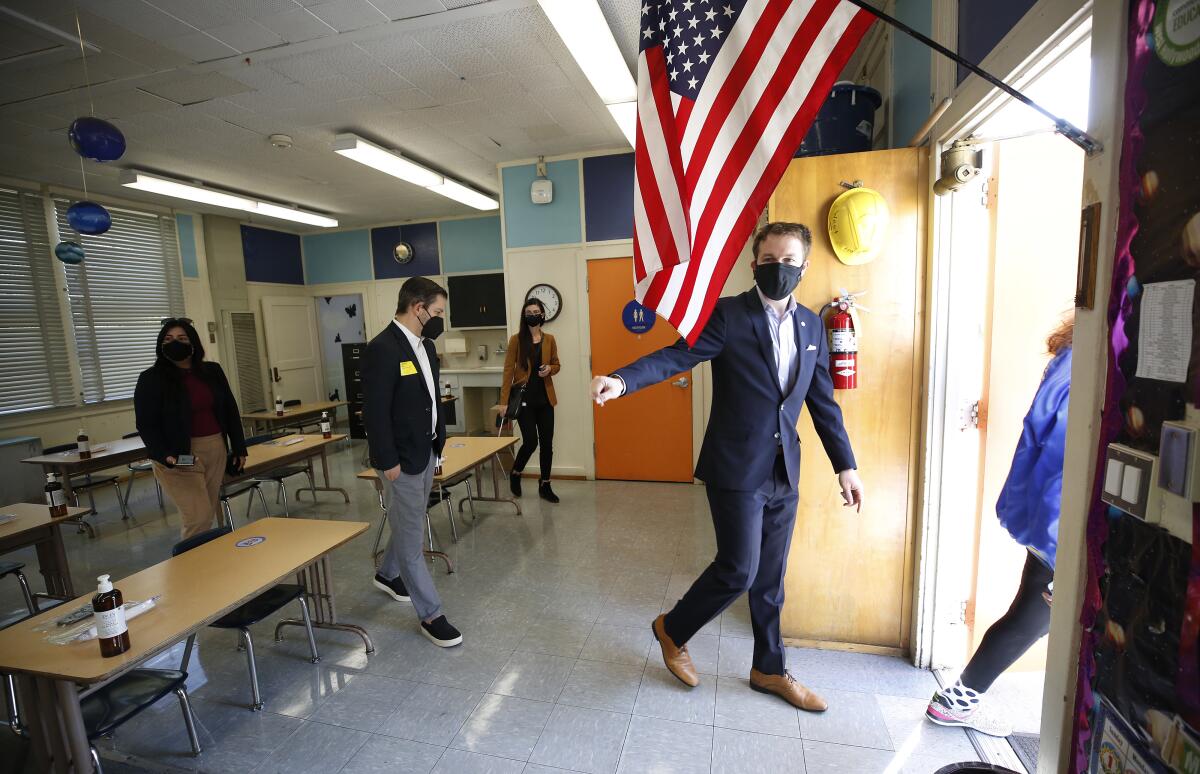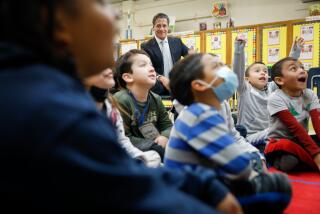LAUSD goes to great lengths to show schools are safe to reopen. But it’s a tough sell

- Share via
Although Vicky Martinez has been dreaming of the day she can send her four children back to in-person instruction in the Los Angeles Unified School District, she thinks that, at least for now, she’s waiting.
But she has had second thoughts. And third thoughts. Her high school son wants to return. Her younger children are afraid of getting COVID-19.
“I am exhausted — physically, mentally, emotionally, financially — all of the above,” she said. “It has been a lot of work, and I feel like I’m failing every day as a parent.”
A personal reckoning is playing out in hundreds of thousands of homes across the nation’s second-largest school district, where families find themselves in a mind-twisting situation. For a year, L.A. school officials have pointedly explained that the prevalence of the coronavirus has made it unsafe to open campuses — messaging strongly reinforced by the teachers union.
Then, after infection rates plummeted — which would have allowed for the immediate reopening of all K-12 grades this month — leaders mobilized to spread the opposite message: Los Angeles schools have “the highest standards of COVID safety of any school district in the nation,” as Supt. Austin Beutner put it in his weekly broadcast on Monday. At more than 40 virtual “town halls,” principal meetings at every school and via online and printed booklets, officials are driving home safety measures in place for gradual reopenings beginning in mid-April — including weekly student coronavirus testing, mandatory masks, upgraded ventilation and air filtration, and stable student-teacher cohorts.
Although large numbers of exasperated parents are ready for the return, the clear majority of parents so far are not sending their children back. Although data on why families are making particular choices is unavailable, The Times has interacted with dozens of parents. Their concerns fall mainly into three buckets: ongoing safety fears; dissatisfaction with what the district is offering, especially for middle and high schools; and logistical issues, including the disruption of now established routines so close to the end of the school year.
More families who live in areas with the highest COVID-19 disease and death rates — the Eastside, South Los Angeles, Southeast L.A. County and the northeast San Fernando Valley — are opting to keep children home even after hearing the safe-schools message. These areas also have the highest concentration of poverty. Overall, about 80% of LAUSD students come from low-income families.
A principal from a hard-hit community agreed to talk to The Times anonymously because he was not authorized to speak. The school district refused to make any principals available to describe their school situation at this key juncture; a spokesperson said they were “too busy.”
The principal spoke of the trauma in his community and said he knew of three families where the father had died — and the deaths of aunts, uncles and grandparents were pervasive, difficult for him to tally with assurance.
“If you think about it too much, it’s mind-boggling and so disheartening and sad,” said the principal. “For the students who’ve gone through that, I believe being on campus and being around friends would lift them up.”
Martinez’s children attend Highland Park-area schools: a second- and fifth-grader at Aldama Elementary, an eighth-grader at Franklin Elementary Dual Language Academy and a 10th-grader at Franklin High School.
“Cases in Los Angeles have decreased dramatically, but it is not nearly enough to make me feel at ease,” said Martinez, who is immunocompromised. “I know many in my circle of friends, family and school communities that have been affected. ... I fear my kids getting COVID and it leading to MIS-C,” she added, referring to multisystem inflammatory syndrome in children, a potentially life-threatening medical condition that has affected a tiny fraction of children infected by the coronavirus.
“We’ve discussed returning to campuses since the beginning of the pandemic and that I wouldn’t feel safe unless they were vaccinated,” Martinez said.
Based on numbers updated through Friday, about 37% of elementary school students would return, along with 24% for middle school and 16% for high school. Those numbers are expected to rise somewhat as more families choose, because those who haven’t yet responded are projected to remain in remote instruction.
Statewide, many parents harbor misgivings.
The California Teachers Assn. on Thursday released survey results indicating that 47% of parents were at least fairly confident that schools were safe for in-person learning; 23% somewhat confident; and 28% not confident — with greater doubts among Latino, Black and Asian American parents than among white parents. In L.A. County, parents felt less assured: 39% confident; 25% somewhat confident; 36% not confident.
One local reopening concern focuses on campus sanitation, after years of decreased school custodial staff — a point brought up by one parent who also teaches adult school in L.A. Unified and requested anonymity because she said she feared being targeted for expressing criticism.
“Most of the adult students I teach all have children at LAUSD schools, and most have told me about the lack of cleanliness and basic supplies at the schools,” said the parent, who recounted purchasing her own supplies and how teachers also would solicit donations from parents.
L.A. Unified officials have emphatically asserted that their reopening plans include frequent cleanings, and Supt. Beutner said custodial staff had been doubled. The district is expected to receive more than $5 billion in state and federal aid to fund these efforts as well as to address learning loss.
“I know there are some concerns about trust,” said school board President Kelly Gonez, “particularly for Black and Latino communities that haven’t been protected by our governmental institutions ... historically and during the pandemic.”
The concerns of Teresa Gaines run in a different direction.
“It’s not that I don’t trust the district,” said Gaines, who has two children at Grand View Boulevard Elementary in Mar Vista. “It’s that I don’t trust 12-plus other families in a cohort to use safe protocols off campus. ... I’m not ready to mix my kids with 60 to 70 people outside of my family.”
Students at all levels will remain in one small group in one classroom during their entire instructional day — on a staggered, half-time schedule. Elementary students will be face-to-face with their teacher, but middle and high school students will log into online classes, just as they would at home, while the teacher in the same room is online, instructing other students in other places. The district’s goal was to limit the mixing of students and avoid disrupting the master schedule so late in the school year.
Other school systems also are struggling with how to handle middle and high school. Many have altered schedules to provide some direct in-person instruction — New York City is among those. Others have allowed students to move from class to class, relying on safety measures such as masking, distancing and sanitation to keep people safe.
No thanks, said Ana Vasquez, who has children at Irving Middle School in northeast Los Angeles and Crenshaw High in South L.A.
“This decision was a no-brainer,” Vasquez said. “Having them sit and Zoom all day long in one specific classroom, wearing that sucky mask all day long, getting tested weekly — plus adding to their risk of them getting infected? Nope! They’re better off at home, where at least they can feel semi-normal. Besides, campus should be for teacher instruction in person — not through Zoom. Totally defeats the purpose.”
There also were parents who said they had no safety concerns and were simply opposed to the Zoom-at-school format.
Some parents and others criticized the district and the teachers union for questioning state and federal safety standards — even after health experts have insisted that schools can reopen safely.
“As a result of that relentless negative messaging, it’s not at all surprising the district now faces a challenge in convincing families to send their kids back,” said Katie Braude, executive director of Speak Up, a local advocacy group. “Districts in other states with similar student demographics confronted this challenge successfully.”
The teachers union declined to answer questions about its role in communicating school safety parameters. In her broadcast update last week, union President Cecily Myart-Cruz took issue with federal guidelines indicating that it was safe to space desks three feet apart rather than six feet — provided that strict safety protocols are followed. She called the guidelines “rash” and based on a “flawed study.”
The district is sticking with a six-foot separation.
Myart-Cruz emphasized making sure that the district lived up to safety commitments, saying, “The focus now is on implementation, enforcement and accountability.”
Martinez, meanwhile, remains torn — her high school son has changed his mind and wants to go back.
“It sounds more like a way to see some friends — I can understand that,” Martinez said. “But he knows that I have final say, and he could be pulled from the hybrid model at any time.”
More to Read
Sign up for Essential California
The most important California stories and recommendations in your inbox every morning.
You may occasionally receive promotional content from the Los Angeles Times.











